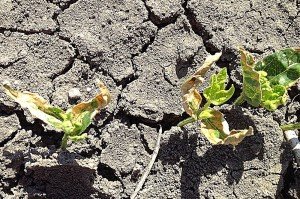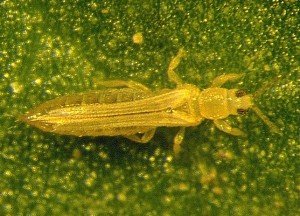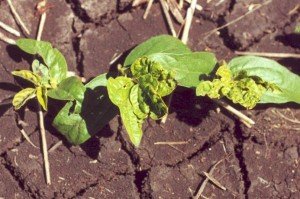There have been several reports of seedling thrips in spring mungbean crops in the Goondiwindi region. Seedling thrips (Thrips tabaci) are also known as winter cereal thrips or cotton seedling thrips. The thrips move out of winter cereals when these start to dry off into new green spring growth such as mungbean, navy beans or cotton. Spring planted crops, especially those in close proximity to maturing cereal crops are at greatest risk. In most cases, early thrips damage does not translate to yield loss. However if you fear an extended thrips invasion and you do spray, please leave some unsprayed strips to determine if the spray was worthwhile.
Description
Adult thrips are 2 mm long and are dark, cigar shaped and have narrow feathery wings folded along their back. Larvae are smaller, lack wings and are pale.
Damage symptoms
Adult thrips can infest a seedling’s growing point as soon as it emerges from the ground. In cracking soils, seedlings may even be infested before they emerge. Larvae feed inside vegetative terminals. Populations typically peak within 4 weeks of plant emergence.
Thrips attack the seedlings growing point and damage the embryonic leaves. However, in mungbean, the damage is usually not manifested until the first trifoliate leaves open. However in some of the Goondiwindi crops, there also appears to be damage to the uni-foliate leaves. Damaged leaves can be severely distorted and discoloured and may resemble herbicide (2,4-D) damage.
In most cases thrips damage is largely cosmetic and will not compromise yield or maturity. In a DAFF trial on the Downs, seedling thrips populations peaked at over 6 per plant terminal at 9 days after emergence (DAE), but crashed to less than 0.5 per plant by 37 DAE. Damage symptoms on newly expanded trifoliate leaves in untreated control plots peaked at severe levels at 16 DAE but crashed to zero in new trifoliate leaves by 37DAE as the crop ‘grew away’ from the early damage. In this trial and a similarly-infested crop at Kingaroy, thrips had no effect on yield or plant maturity (i.e. on time to flowering or harvest), despite seedlings displaying severe leaf distortion.

Seedling thrips damage on the first true leaves in spring mungbeans at Goondiwindi.
Image by Andrew Walker
However if thrips from surrounding cereal crops keep invading mungbean over an extended period of time, they could possibly impact on plant growth and ultimately yield.
Managing thrips
In cold springs, where the mean temperature is below 18°C, slow plant growth and stunting is often wrongly attributed to thrips. Cool weather can however exacerbate thrips damage while warm weather will help plants grow away from the damage hence the risks are higher in the cooler regions.
Monitor for thrips by checking the plant’s growing points. A good hand lens should be used as the pest is very small. Growing points can be submerged in alcohol to dislodge the thrips.
There are no thresholds for seedling thrips in mungbean. Thresholds in seedling cotton of 10 thrips (adult and larvae) and 80% damage to leaves may provide a guide. Remember that thrips damage to new leaves is inflicted in the terminal before they emerge and expand. So spraying spray now won’t undo current damage but would prevent future damage. However the pesticide’s impact may not be obvious immediately, as leaves yet to emerge may have already been damaged.
Before implementing any chemical control, consider that thrips are also important predators of spider mites, other thrips and small eggs.
Thrips can be controlled with dimethoate at a rate of 800mL/ha, under permit PER13155. Apply a narrow band spray over the seedlings to reduce the impact on predators such as spiders in the inter-row. In crops where there is an edge effect (more damage closest to the cereals), consider only spraying the severely damaged proportion of the crop.
Seedling thrips leaf damage can be greatly reduced if dimethoate is applied within 3 days after plant emergence. Spraying after damage symptoms are manifested is usually too late to reduce damage symptoms, unless thrips keep invading from surrounding cereals over an extended period of time.
No seed dressings are currently registered for thrips control in mungbean. If possible, do not plant mungbean crops adjacent to winter cereals. Avoid spring mungbean plantings in regions where cool spring weather is likely, as low temperatures have a far greater impact on mungbean growth than seedling thrips.
Monitor the outcome and compare with unsprayed strips
Where possible, leave some unsprayed strips to see whether pesticide application was really needed and how crops recover from thrips damage. It would also be useful to photograph tagged plants over time in sprayed and unsprayed parts of the crop to ascertain whether there is a variation in time of flowering and maturity, and yield.
Please report any outbreaks to Hugh Brier on 0741 600 740 or 0428 188 069 or email: [email protected]
For information about thrips in seedling cotton visit the beat sheet article on seedling thrips in cotton
Article by Kate Charleston and Hugh Brier


